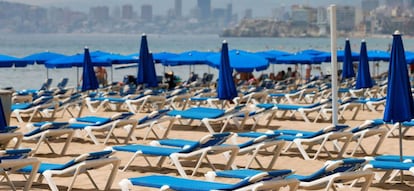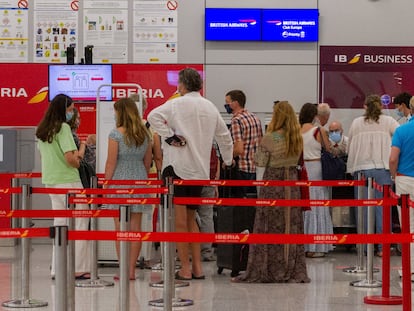Covid-19 crisis devastates Spain’s tourism industry
The sector has recorded its worst semester ever, with a 97% drop in visitors and 750,000 jobs at risk

Spain’s tourism industry continues to feel the impact of the coronavirus crisis. According to figures published Monday by the National Statistics Institute (INE), just 204,926 international visitors arrived in Spain in June, a drop of 97.7% from the same month in 2019. This culminates the worst semester on record for the Spanish tourism industry, with just 10.78 million visitors, a fall of 71.7% from the same period in 2019. Tourist spending in the first half of the year has also plummeted 70.6% to just €11.84 billion.
This means that the sector has lost 27.3 million visitors and €28.4 billion in revenue in the first half of the year compared with the same period last year. And the new outbreaks, coupled with travel advisories issued by several countries, suggest that things will not improve significantly during the second half of the year.
It is the most catastrophic summer season in the last 50 yearsJosé Luis Zoreda, deputy president of Spanish tourism lobby Exceltur
The tourism sector has been one of the hardest-hit by the coronavirus pandemic and the resulting global restrictions on travel. In mid-March, the Spanish government declared a state of alarm in a bid to curb the spread of Covid-19, which limited all non-essential trips to the country. That month, international visitors fell by two thirds. The situation worsened in April and March, with zero tourist arrivals recorded – a previously unthinkable figure in a country where tourism accounts for 11.9% of gross domestic product (GDP). In mid-June, German tourists visited Spain’s Balearic Islands on a pilot program, and on June 21, the state of alarm came to an end and Spain reopened its borders to countries within the Schengen Area (with the exception of Portugal, which reopened on July 1). But despite laxer travel restrictions, Spain’s tourism industry has been unable to bounce back.
All of Spain’s regions recorded a sharp drop in the first half of the year, with tourists arrivals falling 92.2% in the Balearic Islands, 74% in Catalonia, 72.5% in Andalusia and 63.8% in Madrid. Tourist spending also fell in line with the drop in visitors. Although this figure does not represent exactly how much visitors spend in a destination, given that it also includes travel costs, which are paid in the country of origin, it is a good indication of the dire situation the tourism industry is facing. According to the latest figures from the INE, tourists in Spain spent €133 million in June – just 1.4% of the figure from the same month last year.

Making matters worse, several European countries have since issued warnings against travel to regions in Spain, while the United Kingdom, Norway and Slovenia have reimposed quarantine measures on travelers from the country.
Industry groups believe this will result in even greater losses than the €40 billion forecast, and warn that 750,000 jobs may be at risk in the second semester. “It is the most catastrophic summer season in the last 50 years,” says José Luis Zoreda, the deputy president of Spanish tourism lobby Exceltur.
Tourist spending in the first half of the year plummeted 70.6% to just €11.84 billion
“The Spanish tourism industry is facing the most difficult summer in its history,” agrees Juan Ignacio Pulido, a professor of applied economics at the University of Jaén. “We have had other challenging periods, like the crisis of 2008 and 2009, September 11 [terrorist attacks in New York] and the SARS virus in 2003, but there is no comparison to the [2020] fall in tourist numbers.”
The crisis has also impacted air travel. In the first half of the year, 43.5 million travelers passed through airports run by Spain’s airport operator AENA, a fall of 66% from last year’s figures, and 50% less than in 2009, when Spain was suffering from the fallout of the financial crisis. Indeed, in June, more travelers arrived in Spain by road than by plane.
“What is happening is that the recovery is being very slow,” says Javier Gándara, the president of the Airline Association (ALA). The association indicates that there was a 40% drop in flights in June from the same period in 2019. And according to Gándara, the travel warning and quarantine measure introduced by the British government “are going to make the recovery much slower.”
The United Kingdom is the main source of tourists to Spain – in 2019, one in every five visitors to the country was British. Although it’s not yet known what impact the travel measures will have on the sector, Exceltur’s Luis Zoreda warns that in the Mediterranean region, “the Spanish tourism industry will not in any way be able to compensate for the fall in foreign visitors.”
English version by Melissa Kitson.
Tu suscripción se está usando en otro dispositivo
¿Quieres añadir otro usuario a tu suscripción?
Si continúas leyendo en este dispositivo, no se podrá leer en el otro.
FlechaTu suscripción se está usando en otro dispositivo y solo puedes acceder a EL PAÍS desde un dispositivo a la vez.
Si quieres compartir tu cuenta, cambia tu suscripción a la modalidad Premium, así podrás añadir otro usuario. Cada uno accederá con su propia cuenta de email, lo que os permitirá personalizar vuestra experiencia en EL PAÍS.
¿Tienes una suscripción de empresa? Accede aquí para contratar más cuentas.
En el caso de no saber quién está usando tu cuenta, te recomendamos cambiar tu contraseña aquí.
Si decides continuar compartiendo tu cuenta, este mensaje se mostrará en tu dispositivo y en el de la otra persona que está usando tu cuenta de forma indefinida, afectando a tu experiencia de lectura. Puedes consultar aquí los términos y condiciones de la suscripción digital.
More information
Últimas noticias
Maduro pleads not guilty before the federal court in New York: ‘I am still the president of Venezuela’
A new test can detect Alzheimer’s from a finger prick
UN team enters Sudanese city of El Fasher after paramilitary massacre: ‘It’s like a ghost town’
A recipe for resistance: Indigenous peoples politicize their struggles from the kitchen
Most viewed
- Gilles Lipovetsky: ‘If you want to live better and fall in love, take Prozac, don’t look to philosophy’
- Alain Aspect, Nobel laureate in physics: ‘Einstein was so smart that he would have had to recognize quantum entanglement’
- Alvin Hellerstein, a 92-year-old judge appointed by Bill Clinton, to preside over Maduro’s trial in New York
- Why oil has been at the center of Venezuela-US conflicts for decades
- Maduro’s downfall puts China’s relationship with Venezuela to the test










































